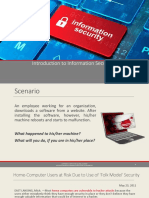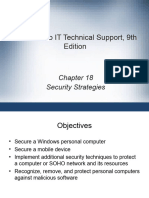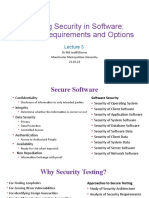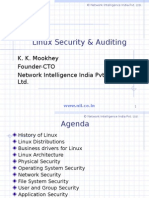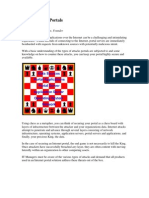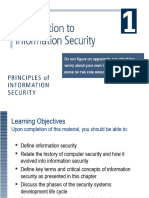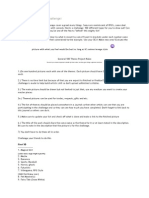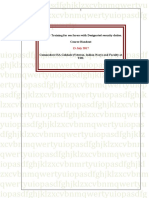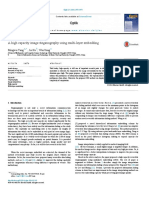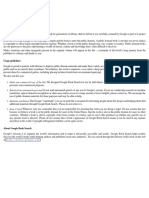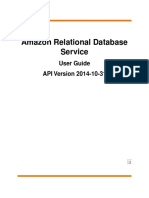Learning Objectives
Upon completion of this material, you should be able to: Define information security Relate the history of computer security and how it evolved into information security Define key terms and critical concepts of information security as presented in this chapter Present the roles of professionals involved in information security within an organization
Principles of Information Security, 3rd Edition
�Introduction
Information security: a well-informed sense of assurance that the information risks and controls are in balance. Jim Anderson, Inovant (2002) Necessary to review the origins of this field and its impact on our understanding of information security today
Principles of Information Security, 3rd Edition
�The History of Information Security
Began immediately after the first mainframes were developed
Groups developing code-breaking computations during World War II created the first modern computers Physical controls to limit access to sensitive military locations to authorized personnel Rudimentary in defending against physical theft, espionage, and sabotage
Principles of Information Security, 3rd Edition 4
�The 1960s
Advanced Research Project Agency (ARPA) began to examine feasibility of redundant networked communications Larry Roberts developed ARPANET from its inception
Principles of Information Security, 3rd Edition
�Figure 1-2 - ARPANET
Principles of Information Security, 3rd Edition
�The 1970s and 80s
ARPANET grew in popularity as did its potential for misuse Fundamental problems with ARPANET security were identified
No safety procedures for dial-up connections to ARPANET
Nonexistent user identification and authorization to system
Late 1970s: microprocessor expanded computing capabilities and security threats
Principles of Information Security, 3rd Edition
�The 1970s and 80s (continued)
Information security began with Rand Report R-609 (paper that started the study of computer security)
Scope of computer security grew from physical security to include:
Safety of data
Limiting unauthorized access to data Involvement of personnel from multiple levels of an organization
Principles of Information Security, 3rd Edition
�MULTICS
Early focus of computer security research was a system called Multiplexed Information and Computing Service (MULTICS) First operating system created with security as its primary goal Mainframe, time-sharing OS developed in mid-1960s by General Electric (GE), Bell Labs, and Massachusetts Institute of Technology (MIT) Several MULTICS key players created UNIX Primary purpose of UNIX was text processing
Principles of Information Security, 3rd Edition 9
�The 1990s
Networks of computers became more common; so too did the need to interconnect networks
Internet became first manifestation of a global network of networks In early Internet deployments, security was treated as a low priority
Principles of Information Security, 3rd Edition
10
�The Present
The Internet brings millions of computer networks into communication with each othermany of them unsecured Ability to secure a computers data influenced by the security of every computer to which it is connected
Principles of Information Security, 3rd Edition
11
�What is Security?
The quality or state of being secureto be free from danger A successful organization should have multiple layers of security in place:
Physical security Personal security Operations security Communications security Network security Information security
12
Principles of Information Security, 3rd Edition
�What is Security? (continued)
The protection of information and its critical elements, including systems and hardware that use, store, and transmit that information Necessary tools: policy, awareness, training, education, technology C.I.A. triangle was standard based on confidentiality, integrity, and availability
C.I.A. triangle now expanded into list of critical characteristics of information
Principles of Information Security, 3rd Edition 13
�Principles of Information Security, 3rd Edition
14
�Critical Characteristics of Information
The value of information comes from the characteristics it possesses:
Availability
Accuracy
Authenticity
Confidentiality Integrity
Utility
Possession
Principles of Information Security, 3rd Edition 15
�Components of an Information System
Information system (IS) is entire set of software, hardware, data, people, procedures, and networks necessary to use information as a resource in the organization
Principles of Information Security, 3rd Edition
16
�Securing Components
Computer can be subject of an attack and/or the object of an attack
When the subject of an attack, computer is used as an active tool to conduct attack When the object of an attack, computer is the entity being attacked
Principles of Information Security, 3rd Edition
17
�Figure 1-5 Subject and Object of Attack
Principles of Information Security, 3rd Edition
18
�Balancing Information Security and Access
Impossible to obtain perfect securityit is a process, not an absolute
Security should be considered balance between protection and availability To achieve balance, level of security must allow reasonable access, yet protect against threats
Principles of Information Security, 3rd Edition
19
�Figure 1-6 Balancing Security and Access
Principles of Information Security, 3rd Edition
20
�Approaches to Information Security Implementation: Bottom-Up Approach
Grassroots effort: systems administrators attempt to improve security of their systems
Key advantage: technical expertise of individual administrators Seldom works, as it lacks a number of critical features:
Participant support Organizational staying power
Principles of Information Security, 3rd Edition 21
�Approaches to Information Security Implementation: Top-Down Approach
Initiated by upper management
Issue policy, procedures, and processes
Dictate goals and expected outcomes of project
Determine accountability for each required action
The most successful also involve formal development strategy referred to as systems development life cycle
Principles of Information Security, 3rd Edition
22
�Principles of Information Security, 3rd Edition
23
�Security Professionals and the Organization
Wide range of professionals required to support a diverse information security program
Senior management is key component; also, additional administrative support and technical expertise are required to implement details of IS program
Principles of Information Security, 3rd Edition
24
�Senior Management
Chief Information Officer (CIO) Senior technology officer Primarily responsible for advising senior executives on strategic planning
Chief Information Security Officer (CISO)
Primarily responsible for assessment, management, and implementation of IS in the organization Usually reports directly to the CIO
Principles of Information Security, 3rd Edition 25
�Information Security Project Team
A number of individuals who are experienced in one or more facets of required technical and nontechnical areas:
Champion
Team leader
Security policy developers
Risk assessment specialists Security professionals
Systems administrators
End users
Principles of Information Security, 3rd Edition 26
�Data Ownership
Data owner: responsible for the security and use of a particular set of information
Data custodian: responsible for storage, maintenance, and protection of information Data users: end users who work with information to perform their daily jobs supporting the mission of the organization
Principles of Information Security, 3rd Edition
27
�Communities of Interest
Group of individuals united by similar interests/values within an organization
Information security management and professionals
Information technology management and professionals Organizational management and professionals
Principles of Information Security, 3rd Edition
28
�Information Security: Is it an Art or a Science?
Implementation of information security often described as combination of art and science
Security artesan idea: based on the way individuals perceive systems technologists since computers became commonplace
Principles of Information Security, 3rd Edition
29
�Security as Art
No hard and fast rules nor many universally accepted complete solutions
No manual for implementing security through entire system
Principles of Information Security, 3rd Edition
30
�Security as Science
Dealing with technology designed to operate at high levels of performance
Specific conditions cause virtually all actions that occur in computer systems Nearly every fault, security hole, and systems malfunction are a result of interaction of specific hardware and software If developers had sufficient time, they could resolve and eliminate faults
Principles of Information Security, 3rd Edition 31
�Security as a Social Science
Social science examines the behavior of individuals interacting with systems
Security begins and ends with the people that interact with the system Security administrators can greatly reduce levels of risk caused by end users, and create more acceptable and supportable security profiles
Principles of Information Security, 3rd Edition
32
�Key Terms
Access Asset Attack Control, Safeguard, or Countermeasure Exploit Exposure Hack Object Risk Security Blueprint Security Model Security Posture or Security Profile Subject Threats Threat Agent Vulnerability
Principles of Information Security, 3rd Edition
33
�Summary
Information security is a well-informed sense of assurance that the information risks and controls are in balance Computer security began immediately after first mainframes were developed Successful organizations have multiple layers of security in place: physical, personal, operations, communications, network, and information
Principles of Information Security, 3rd Edition
34
�Summary (continued)
Security should be considered a balance between protection and availability
Implementation of information security often described as a combination of art and science
Principles of Information Security, 3rd Edition
35
